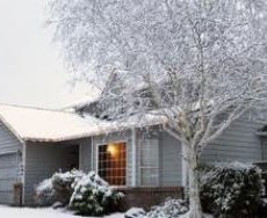 Concerned about how to keep your home warmer when the mercury drops?
Concerned about how to keep your home warmer when the mercury drops?
The U.S. Energy Information Administration estimates that 40 percent of all energy consumption is due to home heating. And renewable energy including solar and wind-generated power account for less than 5 percent of the energy used by homeowners to heat their homes.
Unfortunately, a large percent of the energy used for home heating is wasted due to improper insulation, faulty construction and personal behaviors that don’t focus on energy conservation.
Here are some simple tips to help reduce your energy consumption and costs, and keep your entire home warmer this winter.
Get a Heating Tune Up
Everyone knows that routine maintenance is an essential part of car ownership. The same is true for your home’s heating and air conditioning system. Today’s heating and air conditioning systems are made up of sophisticated mechanical and electrical parts that must be maintained to perform properly.
Routine heating tune ups by a reputable heating repair company can help identify small problems before they become larger, more costly ones. They also ensure that your heating system is clean and working at peak efficiency which reduces energy consumption and costs, and can improve the indoor air quality in your home.
Annual heating tune ups also reduce the risk of fire. According to the Consumer Product Safety Commission, fires from faulty home heating equipment is the leading cause of residential fire deaths, and improper venting of carbon monoxide and other toxic gasses produced by heating systems kills over 200 people each year.
Proper Insulation
Having the proper amount and type of insulation is one of the easiest, most cost-effective ways to keep your home warmer when the mercury drops.
Residential insulation is available in a variety of materials including fiberglass, plastic fibers, natural fibers, foam, and mineral wool which is available in batts and rolls. Foam boards, reflective foils and radiant barriers are also popular choices among homeowners.
These types of insulation can be applied to any finished or unfinished interior wall or ceiling, and fiberglass batts and rolls can be placed between or over exposed beams, joists and studs by any handy do-it-yourselfer.
Blown-in insulation, also known as loose-fill insulation is another popular option, and is a good choice when insulating wall cavities, and existing unfinished areas of your home like your attic.
Fireplace Usage
For most people, fall and winter holidays just aren’t the same without a crackling fireplace. Although they are beautiful, and provide some warmth to the area immediately around them, fireplaces are among the most inefficient forms of home heating. The problem is that most heat created by the fireplaces goes up the chimney. And when the fireplace is not in use, the fireplace and chimney can act like a siphon, sucking warm air out of your home.
To improve the efficiency of your fireplace, consider purchasing a firebox. Fireboxes consist of a metal wood burning stove, surrounded by an outer casing that fits into the fireplace. Indoor air circulates between the inner box and outer shell, and is then delivered into the room.
Call Metro Energy Savers today to schedule a home heating tune up and make sure your home stays warmer this winter.


